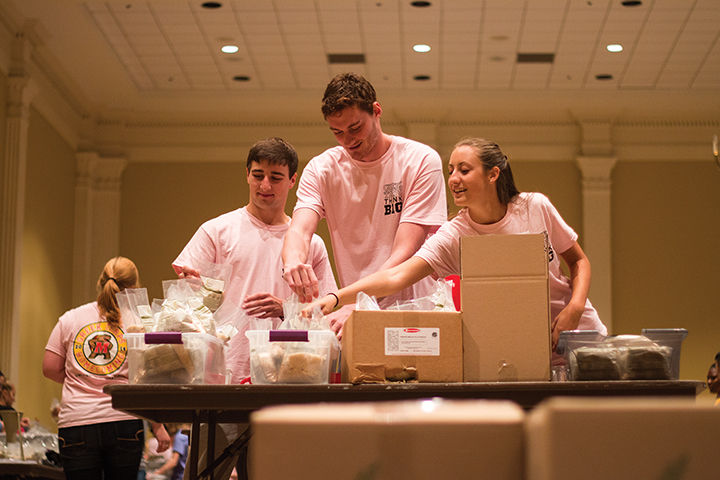By Kimberly Escobar
@kimescobarumd
Staff writer
Student group Terps Against Hunger and the University of Maryland Alumni Association came together for the first time inside the Samuel Riggs IV Center on July 17 to package 42,000 meals for the Capital Area Food Bank.
“People think that joy and happiness comes from things that pleasure them like vacations and great meals — all of the things we enjoy,” said Wanda Alexander, president of the board of governors for the alumni association. “But there is a different kind of satisfaction that comes from knowing … someone else is going to benefit.”
About 190 fellow students, alumni and their family and friends worked for two hours to pack high-nutrition meals, surpassing their goal of 20,000 meals, said Jonathan Fix, Terps Against Hunger founder. The kinds of food packaged included rice, soy protein, dried vegetables and more.
“This event was originally planned for 100,000 meals, but with the short time frame we decided to make it an introductory event and to show [the alumni and university community] what we were doing,” Fix added.
The alumni association had no trouble saying “yes” to Terps Against Hunger, as it often looks for opportunities to help fellow alumni reconnect with the university through service projects like this one, Alexander said.
“We team up with other networks and chapters and organizations to support their efforts,” she said.
Partnering with the alumni association was also a step forward in how Terps Against Hunger wants to hold future events, Fix added. This event was the first of three events that the two organizations will be working on together, with the next one taking place during homecoming in September.
“One of the things that we really want to do moving forward is to make it more of a university-community event,” he said. “Instead of it just being students, faculty and staff, it would bring it up to parents, alumni and the local community.”
Mira Mehta, the Expanded Food and Nutrition Education Program director for the nutrition and food science department, said she is very happy that organizations on the campus are coming together to try and help solve hunger.
“When they carry out plans and implement activities … what is happening is that people are fulfilling an immediate need and are reaching out and helping people who are under-served, impoverished or hungry,” Mehta said. “However, there is also a benefit that allows an opportunity to gain a much better understanding of what causes hunger and what are the sort of the root causes and how to address these causes.”
In the Washington metro area alone, over 641,000 residents are at risk of or experiencing hunger. About 200,000 of them are children, according to the Capital Area Food Bank website. In Maryland, a 2012 survey found that 16.2 percent of households reported an inability to afford enough food, according to the state’s hunger solutions website.
The root causes for hunger often stem from financial hardship, Mehta said, though perspectives on what qualifies as hunger can differ depending on how an individual defines food insecurity.
Food insecurity is defined as the unavailability or limited availability of “nutritionally adequate and safe food,” according to the U.S. Agriculture Department. From 2009-’11, about 12.5 percent of households in this state were food insecure, the website noted.
“Undoubtedly, there are people on the margins of society,” Mehta said. “If you are a hard-working immigrant but are undocumented, or if you are a single mother, people are forced to make a choice between medicines and food, or paying rent or heating their home. … People aren’t necessarily starving in the same way that people may be starving under conditions of famine or conditions, where there is just no food.”



